Does Cold Approaching Work?
The cold approach: where typically a man is brave (or foolish) enough to go up to a woman with no social ties and shoot their shot. This method is of course what pickup artistry mainly revolves around. Just how effective is it? This is what Clark & Hatfield’s (1989) landmark study explored, as well as how the results varied by gender. There aren’t any advanced seduction techniques being deployed here however, instead participants (or ‘confederates’) simply approached opposite-sex students on campus that they considered adequately attractive and after telling them that they’d been checking them out and found them hot they propositioned them with one of three requests: “Would you go out with me tonight?”, “Will you come over to my apartment tonight?”, and “Would you go to bed with me tonight?”.
In the first experiment, while about half of both men and women’s date requests were accepted, none of men’s overt sexual requests and almost none of their apartment requests were accepted compared to about 3/4th of women’s. The second experiment successfully replicated the first.
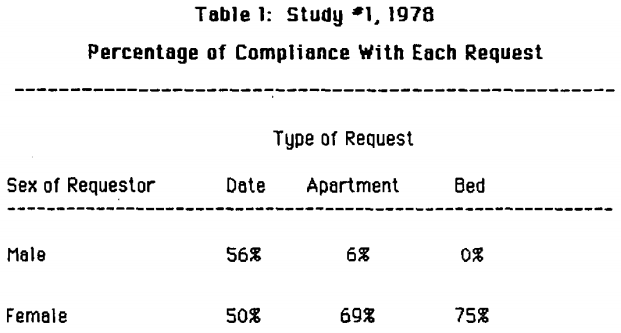
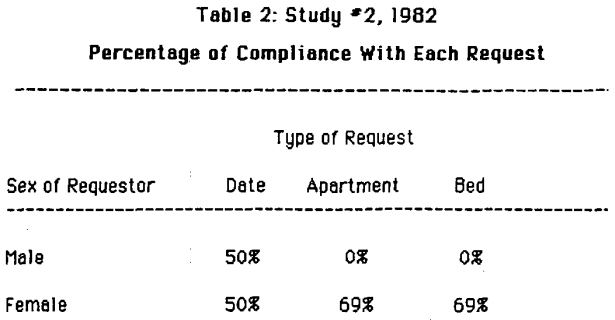
They failed to find an effect of confederate attractiveness on outcomes, maybe due to limited variation as they apparently varied from slightly unattractive to moderately attractive. On a 1-9 scale male confederates rated their subjects 7.7 and female confederates rated theirs 7.3 on average. This would make them more attractive than the confederates themselves, though there is significant room for the influence of subjective taste here.
About a decade on, another study was conducted. The results were largely in line with the previous studies. Even in the midst of the AIDs epidemic, men were as keen as ever for a quick fling.
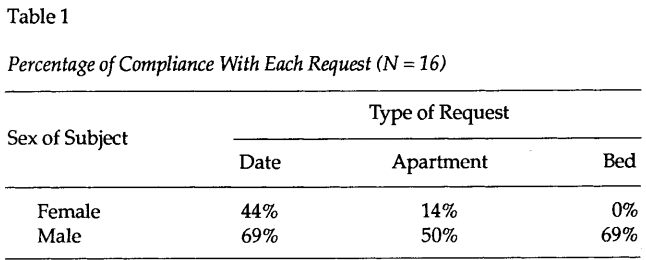
In the second experiment, confederates made the requests to single friends on behalf of other friends who they assured were trustworthy and so on. While almost all of them accepted a date request, there was little change for the bed condition. Only 5% of women accepted the sexual request compared to 50% of men. This means that safety concerns are unlikely to be a significant factor in their unwillingness, reinforced by the fact that only 2 women in the first and none in the second experiment stated that they were a reason for rejecting requests.
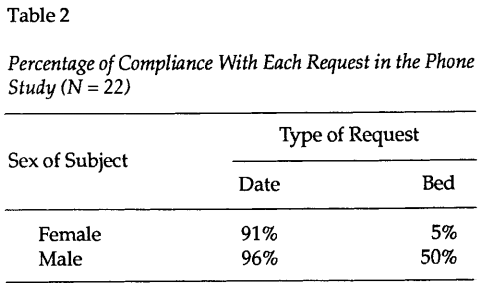
A similar experiment was also conducted in 2003 by a journalist who approached 100 women in German cities for sex (Voracek et al., 2005). Interestingly he claimed no prior knowledge of the previous studies. He was apparently above average in attractiveness. 6 women accepted, and the following encounters were confirmed (by him at least). Five out of six successful approaches were made indoors, four of them in the evening or night-time. Only one was below the age of 30 however, while he was in his late 20s. Two were 38 and one was 50. I guess the takeaway is to go for cougars.
Has sexual openness converged at all as society has become increasingly ‘sex-positive’? The Clark & Hatfield paradigm was eventually revived by Hald & Høgh-Olesen (2010), who had Dutch students approach opposite-sex subjects on a University campus or pedestrian/park areas. The results largely mirrored the original studies’. Only 2% of women accepted the bed request, or 1 of 54. This compares to 38% of men, or 59% of single men. The consent rates for dates were a bit lower in this study with 30% for men and 20% for women (statistically insignificant difference). They found a significant effect of subject-rated attractiveness for male but not female confederates whereby more attractive men had a higher success rate.
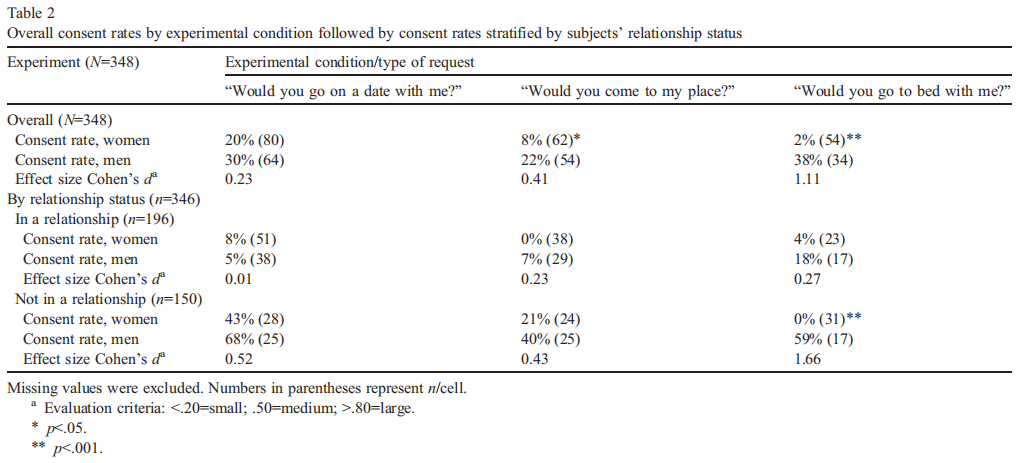
Another such study was conducted by Guéguen et al. (2011). Two men and two women were selected from a group of 14 male and 11 female university students, one of middling attractiveness and one who was rated the highest. Targets were aged 18-25 and were approached in a pedestrian zone in a French town.
Again only 1 of 60 female subjects accepted the bed request. The attractiveness of confederates in this study had a stronger effect on male subjects’ compliance rather than women’s. This is because while it influenced men’s decisions for both requests, it only significantly influenced women’s when it came to the apartment condition.

Baranowski & Hecht (2015) had German students approach subjects on a university campus or student clubs. After confederates approached subjects they rated their attractiveness. The subjects also rated the confederates’ attractiveness and ‘sexual ability’, etc. Those who were approached in the party condition reported how drunk they felt. Confederates also rated the subjects’ drunkenness.
Yet again, just 1 of 52 women accepted the sex request. Contrary to expectations, only male subjects’ consent rates significantly rose in the party condition.
Confederate attractiveness and consent correlated at .29, and perceived sexual skills at .38. These intercorrelated at .53. Self-perceived level of alcohol intoxication correlated with consent rate at .2. Confederates’ ratings of subjects also correlated at .43 with self-perceived intoxication. Ratings of confederate attractiveness correlated with subjects’ drunkenness at .21. So it does seem like alcohol loosens people up a bit and also makes them more forgiving in their looks judgements.

The takeaway
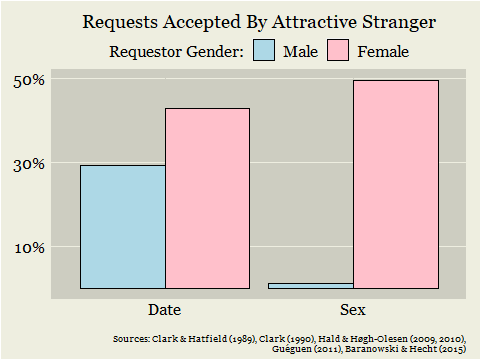
In my opinion the more interesting finding isn’t that women don’t take well to random sexual offers but rather that there is little imbalance when it comes to date offers. A success rate of 1 in 3 or so for average guys seems encouraging, especially compared to dating apps. On the other hand we can only guess how many would’ve ended up flaking. Getting through the door is just the first step as well. After the initial screening stage it may be the case that a greater selectivity gap emerges as women have more criteria beyond surface level characteristics to consider.
As to why women were so unwilling to hookup with strangers? It could be argued that this approach is simply too blunt and on the nose. Just going up to a woman and asking her if she’s dtf would come off as quite autistic. It’s worth considering that the apartment request had a higher success rate, and this is probably a more typical pathway to hookups. In most cases the right atmosphere has to be established first e.g. by Netflix and chilling and then slowly escalating.
Is it because they weren’t chad enough? Even the most attractive men in the studies didn’t have much luck getting women to sleep with them. Another example of this is this tall dark and handsome figure Paul Janka who only slept with 153 of the 3,428 women whose numbers he recorded getting. This would translate to less than a 5% success rate, and this is discounting all the approaches which were flat out rejected.

And how could we forget Johnny Bravo, who despite being an archetypal chad was brutally rejected every single time.
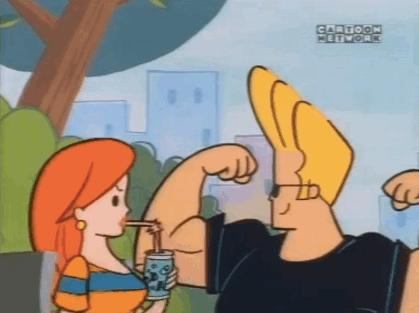
The fantasy of the mythical chad thunderc*ck who just walks up and drops a woman’s panties with a grunt is just that.
This is what we’d expect based on the large sex differences observed in a construct which has been termed ‘sociosexuality’ – essentially how open one is to the prospect of casual sex. These behaviourally revealed preferences mirror stated preferences in openness to casual sexual encounters (Schmitt, 2005), desire for sexual variety (Schmitt, 2003), attitudes toward casual, premarital, and extramarital sex (Oliver & Hyde, 1993), and requiring an emotional connection before engaging in sexual intercourse (Carroll et al., 1985). Moreover, men org*sm following a casual sex encounter at a far higher rate than do women (Piemonte et al., 2019).
The evolutionary basis for these sex differences likely lies in differential minimum parental investment (Trivers, 1972). The concept is relatively simple: the sex in which it’s greater will be more discerning with who they have sex with. Since the extended juvenile period in humans raised parental investment demands very high, they will also typically want to look for signs of commitment first.
Clark (1990) cast doubt on the notion that greater safety concerns were driving the difference. It’s not obvious that accepting a date with a random stranger is all that much less dangerous anyway. Others will bring up sexual double standards and slut-shaming. However, there was no notable difference in experiments conducted more than 30 years later in presumably a more sex-positive cultural context.
It would be interesting to see what the results would look like post-MeToo, but I’d imagine that it’d be harder to get the green light from ethics boards/universities these days. We’re not completely in the dark however. Similar to the previous field experiments, a user posting in the ‘Asian Masculinity’ subreddit approached 117 women and recorded his successes. He recorded 34 numbers, 5 dates, and 4 ‘lays’. Not too far off from the other results we’ve seen. This was during quarantine as well when women were likely behaving more risk aversely than normal. He rated himself a 6-7 and ‘not skinny or fat’, and the majority of girls he had sex with he’d also consider ‘6s-7s’. He also stated that he had comparatively little luck on dating apps.
Date Psychology in a recent survey found that of the men who reported approaching a woman in the past year, 60% had gotten at least one date from it, 47% had sex, and 13% formed a relationship. How ‘cold’ most of these approaches were I don’t know. It seems like it’s probably not a completely dead art at least.
On the other hand a 2018 YouGov survey found that a majority of women reported being uncomfortable being approached in a public space by someone they didn’t know.
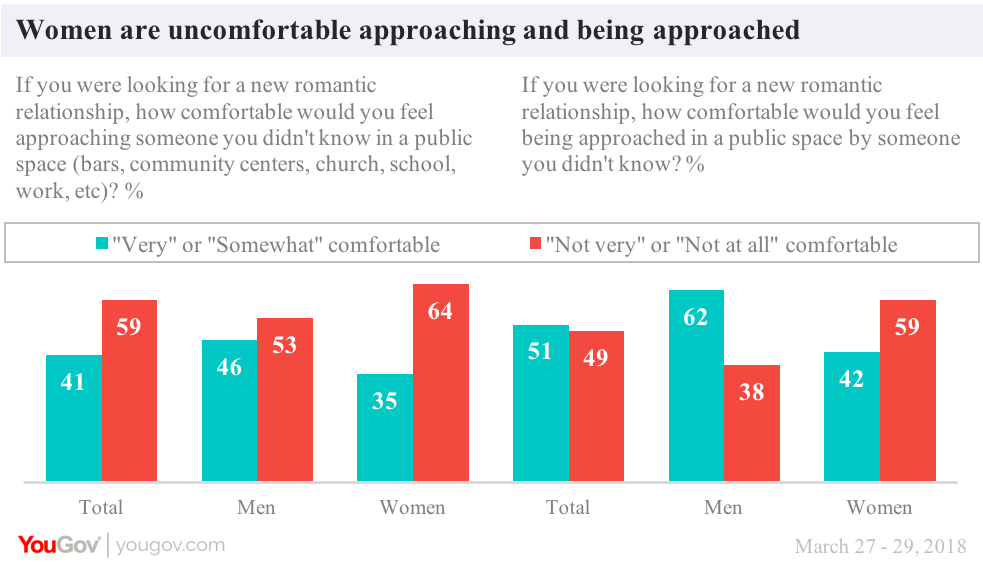
According to a 2023 American Perspectives Survey, contrary to popular belief it’s actually less common for younger than older people to be unacquainted with the people they date. While about half of boomers didn’t know their partner before beginning dating them, about a third of 18-29s didn’t.
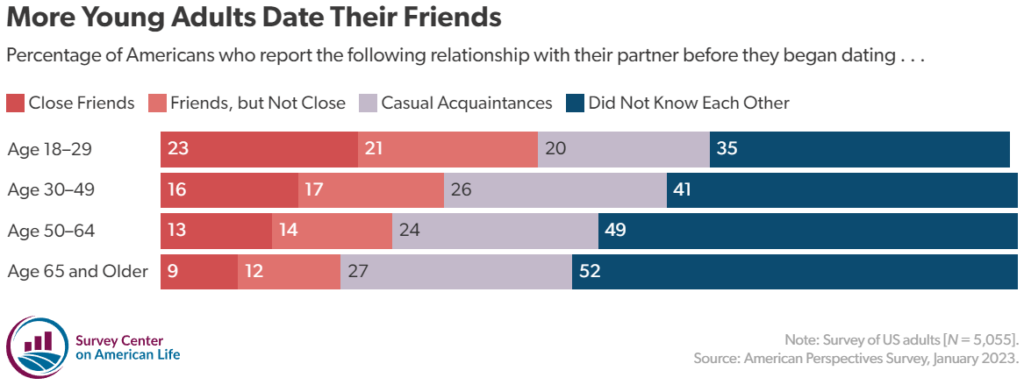
While some might dismiss it as being for ‘beta cucks’ who’ll inevitably get stuck in the friendzone, ‘warm approaching’ is probably more effective and perhaps less intimidating, but of course it takes time to expand your social circle and build rapport. If one has to cold approach, it’d be best to at least wait until you pick up ‘IOIs’ such as extended eye-contact and smiling. For some men of course this may be a longer wait than others. Being around women who share interests would make things easier, but almost by definition most men will tend to have male-typed interests which won’t include many women. I’m not sure if it’s a good idea to sign up for yoga classes just for the purpose of hitting on the women there, it probably wouldn’t take long to get a bad rap.
This isn’t a PUA blog, I’m not giving any advice or the magic pick-up line etc., but for better or worse the traditional script is the way some 90% of dates are arranged (Kendrick & Kepple, 2022) and it doesn’t look like it’s changing any time soon. It’s probably still not the case that online dating is where all the action happens either. How much this data showing that the odds may not be hopelessly bad for getting a number/date is likely to affect someone’s fear approaching I’m not sure. Someone who was too anxiety ridden to do so before probably wasn’t holding back because they logically calculated that the odds of rejection must be a lot higher. It is still a nerve-wracking experience with a high chance of rejection and where one must place their self-esteem and reputation on the line.
References
Clark, R. D., & Hatfield, E. (1989). Gender differences in receptivity to sexual offers. Journal of Psychology & Human Sexuality, 2(1), 39–55. https://doi.org/10.1300/J056v02n01_04
Clark, R. D. (1990). The impact of AIDS on gender differences in willingness to engage in casual sex. Journal of Applied Social Psychology, 20(9, Pt 2), 771–782. https://doi.org/10.1111/j.1559-1816.1990.tb00437.x
Voracek, M., Hofhansl, A., & Fisher, M. L. (2005). Clark and Hatfield’s evidence of women’s low receptivity to male strangers’ sexual offers revisited. Psychological reports, 97(1), 11–20. https://doi.org/10.2466/pr0.97.1.11-20
Hald, G. M., & Høgh-Olesen, H. (2010). Receptivity to sexual invitations from strangers of the opposite gender. Evolution and Human Behavior, 31(6), 453–458. https://doi.org/10.1016/j.evolhumbehav.2010.07.004
Guéguen N. (2011). Effects of solicitor sex and attractiveness on receptivity to sexual offers: a field study. Archives of sexual behavior, 40(5), 915–919. https://doi.org/10.1007/s10508-011-9750-4
Baranowski, A. M., & Hecht, H. (2015). Gender differences and similarities in receptivity to sexual invitations: Effects of location and risk perception. Archives of Sexual Behavior, 44(8), 2257–2265. https://doi.org/10.1007/s10508-015-0520-6
Schmitt D. P. (2005). Sociosexuality from Argentina to Zimbabwe: a 48-nation study of sex, culture, and strategies of human mating. The Behavioral and brain sciences, 28(2), 247–311. https://doi.org/10.1017/s0140525x05000051
Schmitt, D. P., & International Sexuality Description Project. (2003). Universal sex differences in the desire for sexual variety: Tests from 52 nations, 6 continents, and 13 islands. Journal of Personality and Social Psychology, 85(1), 85–104. https://doi.org/10.1037/0022-3514.85.1.85
Oliver, M. B., & Hyde, J. S. (1993). Gender differences in sexuality: a meta-analysis. Psychological bulletin, 114(1), 29–51. https://doi.org/10.1037/0033-2909.114.1.29
Carroll, J. L., Volk, K. D., & Hyde, J. S. (1985). Differences between males and females in motives for engaging in sexual intercourse. Archives of sexual behavior, 14(2), 131–139. https://doi.org/10.1007/BF01541658
Piemonte, J. L., Conley, T. D., & Gusakova, S. (2019). Org*sm, gender, and responses to heterosexual casual sex. Personality and Individual Differences, 151, Article 109487. https://doi.org/10.1016/j.paid.2019.06.030
Trivers, Robert. (1972). Parental Investment and Sexual Selection.
Frankovic, K. (2018). In an increasingly online world, Americans look for love in life. YouGov. https://today.yougov.com/society/articles/20903-americans-prefer-meeting-romantic-partners-offline
Cox, D. (2023). From Swiping to Sexting: The Enduring Gender Divide in American Dating and Relationships. Survey Center on American Life. https://www.americansurveycenter.org/research/from-swiping-to-sexting-the-enduring-gender-divide-in-american-dating-and-relationships/
Kendrick, S., & Kepple, N. J. (2022). Scripting Sex in Courtship: Predicting Genital Contact in Date Outcomes. Sexuality & culture, 26(3), 1190–1214. https://doi.org/10.1007/s12119-021-09938-2
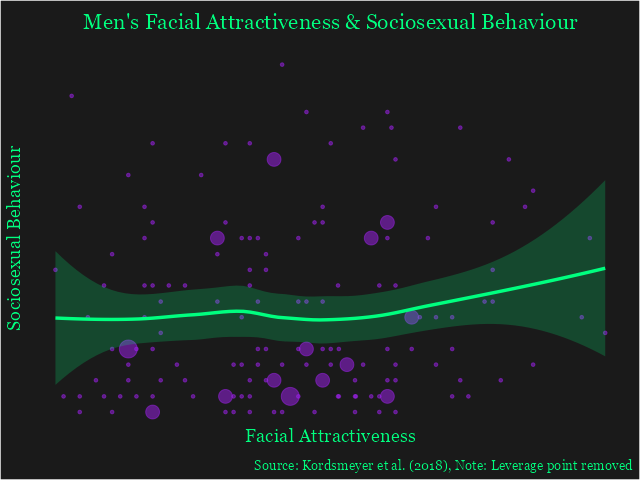


This gateway is incredible. The splendid data displays the administrator’s earnestness. I’m overwhelmed and expect more such astounding material.
I mis-spent my youth in the PUA scene and have done hundreds of cold approaches both off and on university campuses. The odds are much better on a campus because it provides a degree of trust. Cold approaching is a skill that improves with practice so statistics from newbies are not so useful. I should clarify by saying that most guys improve in the first year and then plateau no matter how hard they try. The low odds are compensated for by the infinite opportunities for cold approaching for PUAs with the dedication of Olympic athletes.
Many PUAs (term used loosely) have no success with cold approaching, but improve their confidence and social skills enough to meet someone in a warm approach environment. The real benefit is therefore long term “extroversion maxing”.
Hi i think that i saw you visited my web site thus i came to Return the favore Im attempting to find things to enhance my siteI suppose its ok to use a few of your ideas
Несомненно трендовые новинки моды.
Важные мероприятия известнейших подуимов.
Модные дома, торговые марки, гедонизм.
Интересное место для стильныех хайпбистов.
https://worldsfashion.ru/
Абсолютно актуальные новости подиума.
Исчерпывающие события всемирных подуимов.
Модные дома, лейблы, гедонизм.
Свежее место для модных людей.
https://fashionablelook.ru
Точно свежие события мира fashion.
Абсолютно все события всемирных подуимов.
Модные дома, торговые марки, гедонизм.
Самое приятное место для модных людей.
https://modavgorode.ru
Абсолютно важные новинки мировых подиумов.
Исчерпывающие события лучших подуимов.
Модные дома, торговые марки, высокая мода.
Новое место для трендовых людей.
https://myfashionacademy.ru/
Самые важные новинки моды.
Все эвенты всемирных подуимов.
Модные дома, бренды, гедонизм.
Лучшее место для модных хайпбистов.
https://metamoda.ru/moda/599-doja-cat-vyzvala-bezumie-v-tope-i-yubke-iz-pishchevoy-plenki-s-rezhisserom-vetements-guram-gvasalia/
Абсолютно трендовые новинки моды.
Исчерпывающие мероприятия всемирных подуимов.
Модные дома, лейблы, гедонизм.
Интересное место для модных людей.
https://metamoda.ru/moda/599-doja-cat-vyzvala-bezumie-v-tope-i-yubke-iz-pishchevoy-plenki-s-rezhisserom-vetements-guram-gvasalia/
Hello Neat post Theres an issue together with your site in internet explorer would check this IE still is the marketplace chief and a large element of other folks will leave out your magnificent writing due to this problem
Your ideas absolutely shows this site could easily be one of the bests in its niche. Drop by my website Webemail24 for some fresh takes about Aircon & Heating Services. Also, I look forward to your new updates.
certainly like your website but you need to take a look at the spelling on quite a few of your posts Many of them are rife with spelling problems and I find it very troublesome to inform the reality nevertheless I will definitely come back again
What i do not realize is in fact how you are no longer actually much more wellfavored than you might be right now Youre very intelligent You recognize thus considerably in relation to this topic made me in my view believe it from numerous numerous angles Its like men and women are not fascinated until it is one thing to do with Lady gaga Your own stuffs excellent All the time handle it up
Hi i think that i saw you visited my web site thus i came to Return the favore I am attempting to find things to improve my web siteI suppose its ok to use some of your ideas
Ive read several just right stuff here Certainly price bookmarking for revisiting I wonder how a lot effort you place to create this kind of great informative website
of course like your website but you have to check the spelling on several of your posts A number of them are rife with spelling issues and I in finding it very troublesome to inform the reality on the other hand I will certainly come back again
I have been browsing online more than three hours today yet I never found any interesting article like yours It is pretty worth enough for me In my view if all website owners and bloggers made good content as you did the internet will be a lot more useful than ever before
Thank you for the auspicious writeup It in fact was a amusement account it Look advanced to more added agreeable from you By the way how could we communicate
helloI really like your writing so a lot share we keep up a correspondence extra approximately your post on AOL I need an expert in this house to unravel my problem May be that is you Taking a look ahead to see you
Your blog is a treasure trove of valuable insights and thought-provoking commentary. Your dedication to your craft is evident in every word you write. Keep up the fantastic work!
you are in reality a good webmaster The website loading velocity is amazing It sort of feels that youre doing any distinctive trick Also The contents are masterwork you have done a fantastic job in this topic
Your work has captivated me just as much as it has captivated you. The visual display is elegant, and the written content is impressive. Nevertheless, you seem concerned about the possibility of delivering something that may be viewed as dubious. I agree that you’ll be able to address this issue promptly.
I was reading some of your blog posts on this site and I believe this
web site is rattling instructive! Continue putting up.Raise blog
range
Its like you read my mind You appear to know so much about this like you wrote the book in it or something I think that you can do with a few pics to drive the message home a little bit but instead of that this is excellent blog A fantastic read Ill certainly be back
Real Estate I like the efforts you have put in this, regards for all the great content.
Live Coin Watch I’m often to blogging and i really appreciate your content. The article has actually peaks my interest. I’m going to bookmark your web site and maintain checking for brand spanking new information.
Fourweekmba I like the efforts you have put in this, regards for all the great content.
Nice blog here Also your site loads up very fast What host are you using Can I get your affiliate link to your host I wish my site loaded up as quickly as yours lol
It is a pity, that now I can not express – it is very occupied. I will return – I will necessarily express the opinion.
Hi, I’m Jack. Your blog is a treasure trove of valuable insights, and I’ve made it a point to visit daily. Kudos on creating such an amazing resource!
about 1xBet
Модные заметки по подбору крутых луков на любой день.
Статьи экспертов, события, все коллекции и шоу.
https://rftimes.ru/news/2024-08-14-7-samyh-kultovyh-veshchey-ot-balenciaga
https://linebet-in-bd.com/
I have been exploring for a little for any high-quality articles or blog posts on this sort of space . Exploring in Yahoo I finally stumbled upon this web site. Reading this information So i?¦m happy to convey that I have a very good uncanny feeling I found out just what I needed. I such a lot indisputably will make certain to don?¦t forget this web site and provides it a look regularly.
Tech to Trick very informative articles or reviews at this time.
Nutra Gears You’re so awesome! I don’t believe I have read a single thing like that before. So great to find someone with some original thoughts on this topic. Really.. thank you for starting this up. This website is something that is needed on the internet, someone with a little originality!
I do believe all the ideas youve presented for your post They are really convincing and will certainly work Nonetheless the posts are too short for novices May just you please lengthen them a little from subsequent time Thanks for the post
Wow amazing blog layout How long have you been blogging for you made blogging look easy The overall look of your web site is magnificent as well as the content
Tech to Force I like the efforts you have put in this, regards for all the great content.
Hello Neat post Theres an issue together with your site in internet explorer would check this IE still is the marketplace chief and a large element of other folks will leave out your magnificent writing due to this problem
Its like you read my mind You appear to know so much about this like you wrote the book in it or something I think that you can do with a few pics to drive the message home a little bit but other than that this is fantastic blog A great read Ill certainly be back
I loved as much as you will receive carried out right here The sketch is tasteful your authored subject matter stylish nonetheless you command get got an edginess over that you wish be delivering the following unwell unquestionably come further formerly again as exactly the same nearly very often inside case you shield this hike
Somebody essentially lend a hand to make significantly articles Id state That is the very first time I frequented your website page and up to now I surprised with the research you made to make this actual submit amazing Wonderful task
Somebody essentially help to make significantly articles Id state This is the first time I frequented your web page and up to now I surprised with the research you made to make this actual post incredible Fantastic job
I like what you guys are up also. Such intelligent work and reporting! Keep up the superb works guys I have incorporated you guys to my blogroll. I think it will improve the value of my site 🙂
Стильные заметки по подбору необычных образов на любой день.
Заметки экспертов, события, все коллекции и шоу.
https://luxe-moda.ru/chic/499-10-maloizvestnyh-faktov-o-demne-gvasalii/